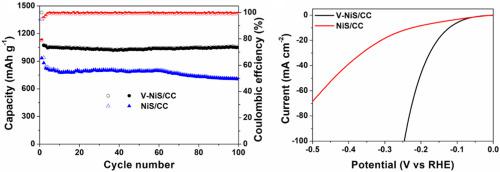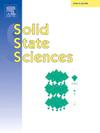V-doped NiS on carbon fiber cloth for improved electrochemical lithium storage and hydrogen evolution reaction
Abstract
Promoting the intrinsic electronic structure and conductivity by hetero-element doping technique is an effective solution to acquire improved electrochemical energy storage and conversion activities of transition metals based materials. Herein, the rationally designed integrated electrode of vanadium doped NiS nanoparticles supported on carbon fiber cloth (V–NiS/ CC) is prepared via a one-step hydrothermal method. The physical analysis reveals the successful and homogeneous doping of vanadium in NiS. The electrochemical measurements indicate that V-doping is crucial to improve the electrochemical properties of NiS for lithium storage and water splitting. As anode for lithium-ion battery, V–NiS/CC exhibits high reversible capacity of 1056.3 mAh g−1 after 100 cycles at 0.1 A g−1 and good rate performance. Additionally, a low overpotential of 121 mV is achieved to generate catalysis current density of 10 mA cm−2 when V–NiS/CC serves for electrocatalytic hydrogen evolution. The remarkable electrochemical properties should be due to the optimized electronic structure and conductivity that are endowed by vanadium doping. This work provides a solid proof to design heteroatom doped transition metal sulfides for promising applications in electrochemical energy storage and conversion.



 求助内容:
求助内容: 应助结果提醒方式:
应助结果提醒方式:


